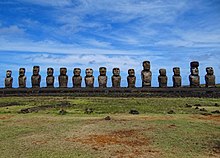
Rapa Nui mythology, also known as Pascuense mythology or Easter Island mythology, refers to the native myths, legends, and beliefs of the Rapa Nui people of Easter Island in the south eastern Pacific Ocean.
Origin myth
Main article: Hotu Matu'aAccording to Rapa Nui mythology Hotu Matuꞌa was the legendary first settler and ariki mau ("supreme chief" or "king") of Easter Island. Hotu Matu'a and his two-canoe (or one double-hulled canoe) colonising party were Polynesians from the now unknown land of Hiva Nuku Hiva, Hiva Oa, Fatu Hiva, Mount Oave, Marquesas Islands, Tahiti, Fenua. They landed at Anakena beach and his people spread out across the island, sub-divided it between clans claiming descent from his sons, and lived for more than a thousand years in their isolated island home at the southeastern tip of the Polynesian Triangle until the arrival of Dutch captain Jacob Roggeveen, who arrived at the island in 1722.
Ancestor cult
Main article: MoaiThe most visible element in the culture was the production of massive statues called moai that represented deified ancestors. It was believed that the living had a symbiotic relationship with the dead where the dead provided everything that the living needed (health, fertility of land and animals, fortune, etc.), and the living through offerings provided the dead with a better place in the spirit world. Most settlements were located on the coast and moai were erected along the coastline, watching over their descendants in the settlements before them, with their backs toward the spirit world in the sea.
Tangata manu cult
Main article: Tangata manuThe Tangata manu or bird-man cult succeeded the island's Moai era when warfare erupted over dwindling natural resources and construction of statues stopped. The deity Make-make was the chief god of the birdman cult. The cult declined after the island population adopted Catholicism, though the birdman's popularity and memory were not erased and it is still present in the decoration of the island's church.
Deities and heroes
- Make-make, creator of humanity
- Uoke, tectonic deity
- Hotu Matu'a, legendary king and cultural hero
- Aku-Aku, spirits of the dead
- Manana Take
- Tangata manu
- Hanau epe
- Haua
- Hina-Oio
References
- Carlos Mordo, Easter Island (Willowdale, Ontario: Firefly Books Ltd., 2002)
- Steven L. Danver (22 December 2010). Popular Controversies in World History: Investigating History's Intriguing Questions. ABC-CLIO. pp. 223–224. ISBN 978-1-59884-077-3. Retrieved 10 January 2012.
- Barbara A. West (2009). Encyclopedia of the peoples of Asia and Oceania. Infobase Publishing. pp. 683–684. ISBN 978-0-8160-7109-8. Retrieved 10 January 2012.
- Phil Cousineau (1 July 2003). Once and Future Myths: The Power of Ancient Stories in Our Lives. Conari Press. pp. 181–182. ISBN 978-1-57324-864-8. Retrieved 12 January 2012.
- Steven L. Danver (22 December 2010). Popular Controversies in World History: Investigating History's Intriguing Questions. ABC-CLIO. p. 225. ISBN 978-1-59884-077-3. Retrieved 10 January 2012.
Further reading
- Kjellgren, Eric; et al. (2001). Splendid isolation: art of Easter Island. New York: The Metropolitan Museum of Art. ISBN 9781588390110.
- Robert D. Craig. Dictionary of Polynesian mythology. Greenwood Publishing Group, 1989 ISBN 0-313-25890-2, ISBN 978-0-313-25890-9
- Peggy Mann. Easter Island: land of mysteries. Holt, Rinehart, and Winston, 1976. ISBN 0-03-014056-0, ISBN 978-0-03-014056-3
External links
- Easter Island legends and myths - Easter Island Traveling
| Polynesian mythology | ||
|---|---|---|
| Mythology by region |  | |
| Paganism (and modern paganism) | |||||||||||||||||||||||||||||||||||||||||
|---|---|---|---|---|---|---|---|---|---|---|---|---|---|---|---|---|---|---|---|---|---|---|---|---|---|---|---|---|---|---|---|---|---|---|---|---|---|---|---|---|---|
| Historical ethnic religions (list) (existing and extinct) |
| ||||||||||||||||||||||||||||||||||||||||
| Modern paganism (movements) |
| ||||||||||||||||||||||||||||||||||||||||
| Myth and ritual | |||||||||||||||||||||||||||||||||||||||||
| Christianization | |||||||||||||||||||||||||||||||||||||||||
| Easter Island | ||||||
|---|---|---|---|---|---|---|
| Culture |
|  | ||||
| Geography and geology | ||||||
| Administration |
| |||||
| Culture of indigenous Oceania | |||||||||||||
|---|---|---|---|---|---|---|---|---|---|---|---|---|---|
| List of resources about traditional arts and culture of Oceania | |||||||||||||
| Art | |||||||||||||
| Broad culture | |||||||||||||
| Geo-specific, general |
| ||||||||||||
| Canoes | |||||||||||||
| Dance | |||||||||||||
| Festivals | |||||||||||||
| Languages |
| ||||||||||||
| Literature |
| ||||||||||||
| Music |
| ||||||||||||
| Mythology | |||||||||||||
| Research | |||||||||||||
| People |
| ||||||||||||
| Religion |
| ||||||||||||
| For other topics including Oceanian cinema, indigenous currency, dress, folklore and cuisine, see Category:Culture of Oceania. | |||||||||||||
This article related to the culture of Chile is a stub. You can help Misplaced Pages by expanding it. |
This article relating to a myth or legend from Oceania is a stub. You can help Misplaced Pages by expanding it. |